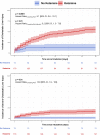Long-term ketamine infusion-induced cholestatic liver injury in COVID-19-associated acute respiratory distress syndrome
- PMID: 35606831
- PMCID: PMC9125956
- DOI: 10.1186/s13054-022-04019-8
Long-term ketamine infusion-induced cholestatic liver injury in COVID-19-associated acute respiratory distress syndrome
Abstract
Background: A higher-than-usual resistance to standard sedation regimens in COVID-19 patients suffering from acute respiratory distress syndrome (ARDS) has led to the frequent use of the second-line anaesthetic agent ketamine. Simultaneously, an increased incidence of cholangiopathies in mechanically ventilated patients receiving prolonged infusion of high-dose ketamine has been noted. Therefore, the objective of this study was to investigate a potential dose-response relationship between ketamine and bilirubin levels.
Methods: Post hoc analysis of a prospective observational cohort of patients suffering from COVID-19-associated ARDS between March 2020 and August 2021. A time-varying, multivariable adjusted, cumulative weighted exposure mixed-effects model was employed to analyse the exposure-effect relationship between ketamine infusion and total bilirubin levels.
Results: Two-hundred forty-three critically ill patients were included into the analysis. Ketamine was infused to 170 (70%) patients at a rate of 1.4 [0.9-2.0] mg/kg/h for 9 [4-18] days. The mixed-effects model revealed a positively correlated infusion duration-effect as well as dose-effect relationship between ketamine infusion and rising bilirubin levels (p < 0.0001). In comparison, long-term infusion of propofol and sufentanil, even at high doses, was not associated with increasing bilirubin levels (p = 0.421, p = 0.258). Patients having received ketamine infusion had a multivariable adjusted competing risk hazard of developing a cholestatic liver injury during their ICU stay of 3.2 [95% confidence interval, 1.3-7.8] (p = 0.01).
Conclusions: A causally plausible, dose-effect relationship between long-term infusion of ketamine and rising total bilirubin levels, as well as an augmented, ketamine-associated, hazard of cholestatic liver injury in critically ill COVID-19 patients could be shown. High-dose ketamine should be refrained from whenever possible for the long-term analgosedation of mechanically ventilated COVID-19 patients.
Keywords: Chemical and drug-induced liver injury; Cholangiopathy; Cholangitis; Cholestasis; Hypnotics and sedatives.
© 2022. The Author(s).
Conflict of interest statement
The authors declare no conflicts of interest.
Figures




References
-
- Santé A-ANdSdMedPd: Kétamine: risque d’atteintes uro-néphrologiques, endocriniennes et hépatiques graves lors d’utilisations prolongées et/ou à doses élevées – Rappel de l’importance du respect du bon usage. In. Edited by Santé ANdSdMedPd. https://ansm.sante.fr: ANSM; 2018.
Publication types
MeSH terms
Substances
LinkOut - more resources
Full Text Sources
Medical

